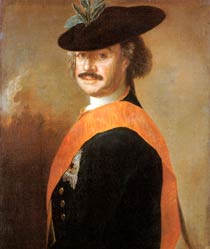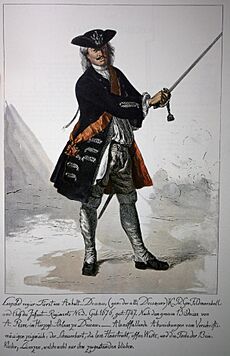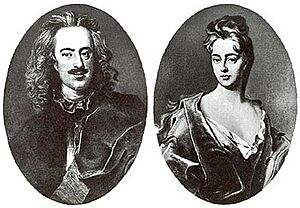Leopold I, Prince of Anhalt-Dessau facts for kids
Quick facts for kids Leopold I |
|
|---|---|
| Prince of Anhalt-Dessau | |
 |
|
| Prince of Anhalt-Dessau | |
| Reign | 7 August 1693 – 7 April 1747 |
| Predecessor | John George II |
| Successor | Leopold II |
| Born | 3 July 1676 Dessau, Anhalt-Dessau |
| Died | 7 April 1747 (aged 70) Dessau, Anhalt-Dessau |
| Spouse | Anna Louise Föhse |
| Issue | William Gustav, Hereditary Prince of Anhalt-Dessau Leopold II Prince Dietrich, later Regent Prince Frederick Henry Eugen Princess Henriette Marie Louise Louise, Princess of Anhalt-Bernburg Prince Maurice Princess Anna Wilhelmine Leopoldine Marie, Margravine of Brandenburg-Schwedt Princess Henriette Amalie John Georg Henry von Berenhorst Karl Franz von Berenhorst |
| House | Ascania |
| Father | John George II, Prince of Anhalt-Dessau |
| Mother | Henriette Catherine of Nassau |
| Signature | |
Leopold I, Prince of Anhalt-Dessau (born 3 July 1676 – died 7 April 1747) was a German prince. He belonged to the House of Ascania and ruled the small state of Anhalt-Dessau from 1693 to 1747. He was also a very important military leader, known as a Generalfeldmarschall (Field Marshal) in the Prussian Army.
People often called him "the Old Dessauer" (which means der alte Dessauer in German). He was a good commander in battles, but he was most famous for being an amazing drillmaster. He completely changed and improved the way the Prussian infantry (foot soldiers) fought.
In 1712, King Frederick I made Leopold a field marshal. Leopold showed his skills during the War of the Spanish Succession. Later, he led the Prussian and Saxon armies in the Great Northern War against Sweden. Leopold was also a close friend of King Frederick William I. His last big military success was leading the Prussian troops to victory against the Saxons at the Battle of Kesselsdorf in 1745. This happened during the Second Silesian War.
Contents
Early Life and Becoming a Prince
Leopold was born in Dessau. He was one of ten children of John George II, Prince of Anhalt-Dessau, and his wife Henriette Catherine of Nassau. From a very young age, Leopold loved everything about the military. He trained himself to be strong and smart for a soldier's life.
In 1693, he became a colonel in a Prussian regiment. In the same year, he inherited his own small state, Anhalt-Dessau. For the rest of his life, he was both a ruling prince and a Prussian officer.
Leopold's first military experience was in 1695 in the Netherlands. He was part of the Siege of Namur. He stayed in the army until the war ended in 1697. During this time, his mother, Princess Henriette Katharina, mostly managed the government of Anhalt-Dessau.
Leopold's Military Career
Leopold's important role as a soldier began when the War of the Spanish Succession started in 1701. He made many improvements to the Prussian army. One big change was introducing the iron ramrod around 1700, which helped soldiers load their guns faster.
Fighting in the Spanish Succession War
Leopold led a Prussian group on the Rhine River. He helped in the sieges of Kaiserswerth and Venlo in 1702. The next year, he became a lieutenant-general. He took part in the Siege of Bonn. He also fought in the Battle of Hochstadt in 1703, where the Austrians and Prussians lost to the French.
In 1704, the Prussian soldiers under Leopold fought at Blenheim. In 1705, Leopold and his Prussian soldiers joined Prince Eugene in Italy. They fought in the Battle of Cassano. At the Battle of Turin in 1706, Leopold was one of the first to break through the enemy's defenses.
He fought in one more campaign in Italy. Then, he joined Marlborough in the Netherlands. He was present at the Siege of Tournai and the Battle of Malplaquet in 1709.
By 1710, Leopold was in charge of all Prussian soldiers on the French front. In 1712, he became a field marshal. This was a special request from the crown prince of Prussia, Frederick William, who had served with Leopold. Leopold was a very important person in the Prussian government during the early rule of King Frederick William I.
The Great Northern War
Even though Prussia was against Sweden, they didn't want to join the Great Northern War at first. But after the Russians badly defeated the Swedish army, Prussia joined the war in 1715. Leopold went with the king to the war front. He led an army of 40,000 men. He defeated the smaller army of Charles XII of Sweden in a tough battle on the island of Rügen in November 1715. This was done with the help of the Danish army.
Training the Prussian Army
Before 1740, the Prussian army was not considered one of Europe's strongest. But Leopold's greatest achievement was training the Prussian infantry. He was a very strict leader, even for his time. Because of his training, the Prussian infantry became a very powerful fighting force. Their true strength was shown later in battles.
Leopold focused mostly on infantry. He didn't pay as much attention to the cavalry (soldiers on horseback). This caused some problems in the Battle of Mollwitz in 1741. However, the strong infantry he trained was key to later Prussian victories.
With the support of King Frederick William I, Leopold spent twenty years improving the army. During this time, he helped Crown Prince Frederick (who later became Frederick the Great) get back into the Prussian army after a difficult situation. He also played a successful role in the War of the Polish Succession on the Rhine, serving under his old commander, Eugene of Savoy.
Service Under Frederick the Great
When King Frederick William died in 1740, Frederick the Great became king. A few months later, Frederick invaded Silesia, starting the long Silesian Wars. This was the real test for the Prussian army that Leopold had worked so hard to improve.
Leopold himself was not often in command of the king's main army. However, his sons held high positions under Frederick. The king found Leopold a bit difficult to manage, so Leopold spent most of the war years until 1745 commanding an army watching the Saxon border.
In early 1745, Leopold's wife passed away. Leopold was over seventy years old, but his last military campaign was his most successful. The Austrians and Saxons tried to attack Berlin in winter. The Prussians quickly gathered their forces. Frederick stopped the main Austrian army and rushed towards Dresden.
But before Frederick arrived, Leopold won a huge victory over the Saxons at Kesselsdorf on 14 December 1745. Leopold was a very religious Lutheran. He always prayed before battles. On this last battlefield, he famously prayed, "O Lord God, let me not be disgraced in my old days. Or if Thou wilt not help me, do not help these scoundrels, but leave us to try it ourselves."
This great victory marked the end of Leopold's military career. When Frederick arrived after the battle, he personally hugged "the Old Dessauer." Leopold then retired from active service and spent the rest of his life in Dessau.
His son, Leopold II Maximilian, became the new prince of Anhalt-Dessau. Two other sons, Dietrich of Anhalt-Dessau and Moritz of Anhalt-Dessau, also became famous Prussian generals.
Family Life
When Leopold was a young prince, he fell in love with Anna Louise Föhse. She was the daughter of an apothecary (a type of pharmacist) in Dessau. His mother tried to stop their relationship by sending Leopold on a long trip, but it didn't work.
In 1698, one year after he became an adult, Leopold married his beloved Anna Louise in Dessau. Their marriage was special because Anna Louise was not from a royal family. However, in 1701, the Emperor Leopold I made Anna Louise an Imperial Princess. He also declared that all their children would be considered princes and princesses of Anhalt. King Frederick I of Prussia and other royal family members agreed to this.
Leopold and Anna Louise had a long and happy marriage. They had ten children:
- William Gustav (1699–1737), who was the Hereditary Prince.
- Leopold II Maximilian (1700–1751), who became Prince of Anhalt-Dessau.
- Dietrich (1702–1769), who later became a Regent.
- Frederick Henry Eugen (1705–1781).
- Henriette Marie Louise (1707–1707).
- Louise (1709–1732), who married Victor Frederick, Prince of Anhalt-Bernburg.
- Maurice (1712–1760).
- Anna Wilhelmine (1715–1780).
- Leopoldine Marie (1716–1782), who married Frederick Henry, Margrave of Brandenburg-Schwedt.
- Henriette Amalie (1720–1793).
Princess Anna Louise had a lot of influence over her husband. She always tried to help his people. After Leopold's mother died, Anna Louise managed the government when Leopold was away fighting. She often even went with him to the battlefield.
Images for kids
See also
- Statue of Leopold I, Prince of Anhalt-Dessau, Berlin
- Dessauer Marsch
|
Leopold I, Prince of Anhalt-Dessau
House of Ascania
Born: 3 July 1676 Died: 7 April 1747 |
||
| Regnal titles | ||
|---|---|---|
| Preceded by John George II |
Prince of Anhalt-Dessau 1693–1747 |
Succeeded by Leopold II |





